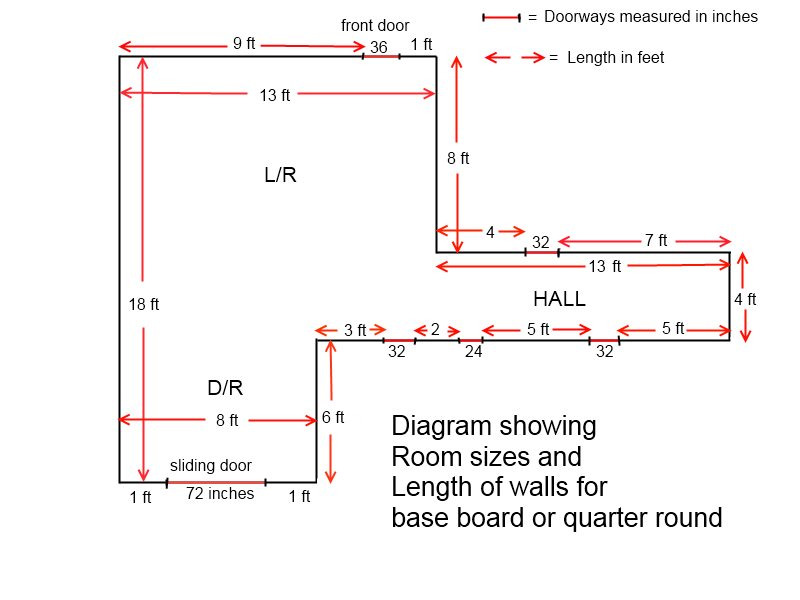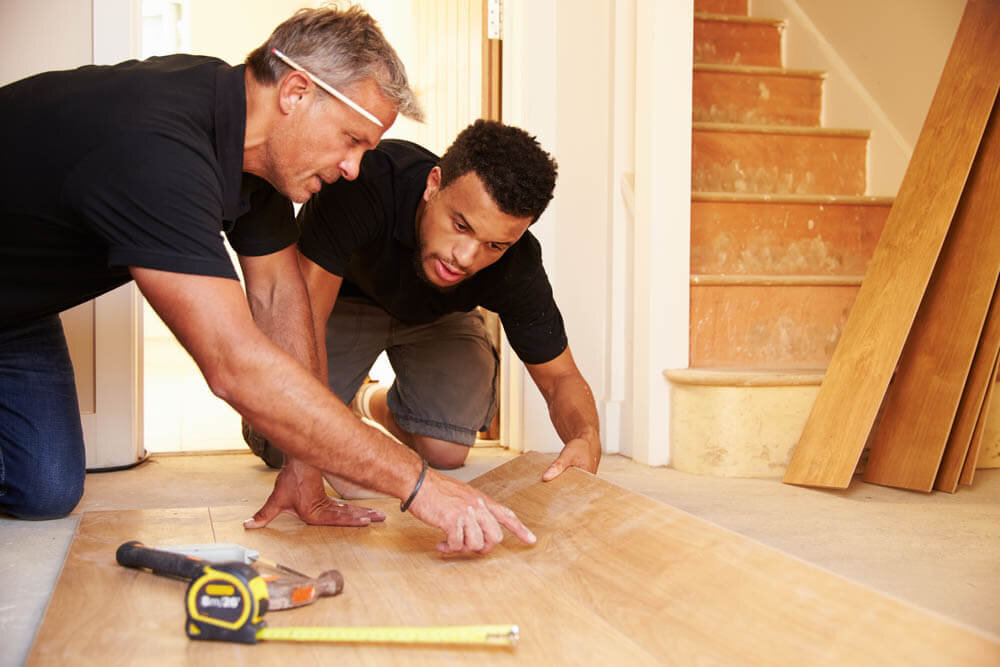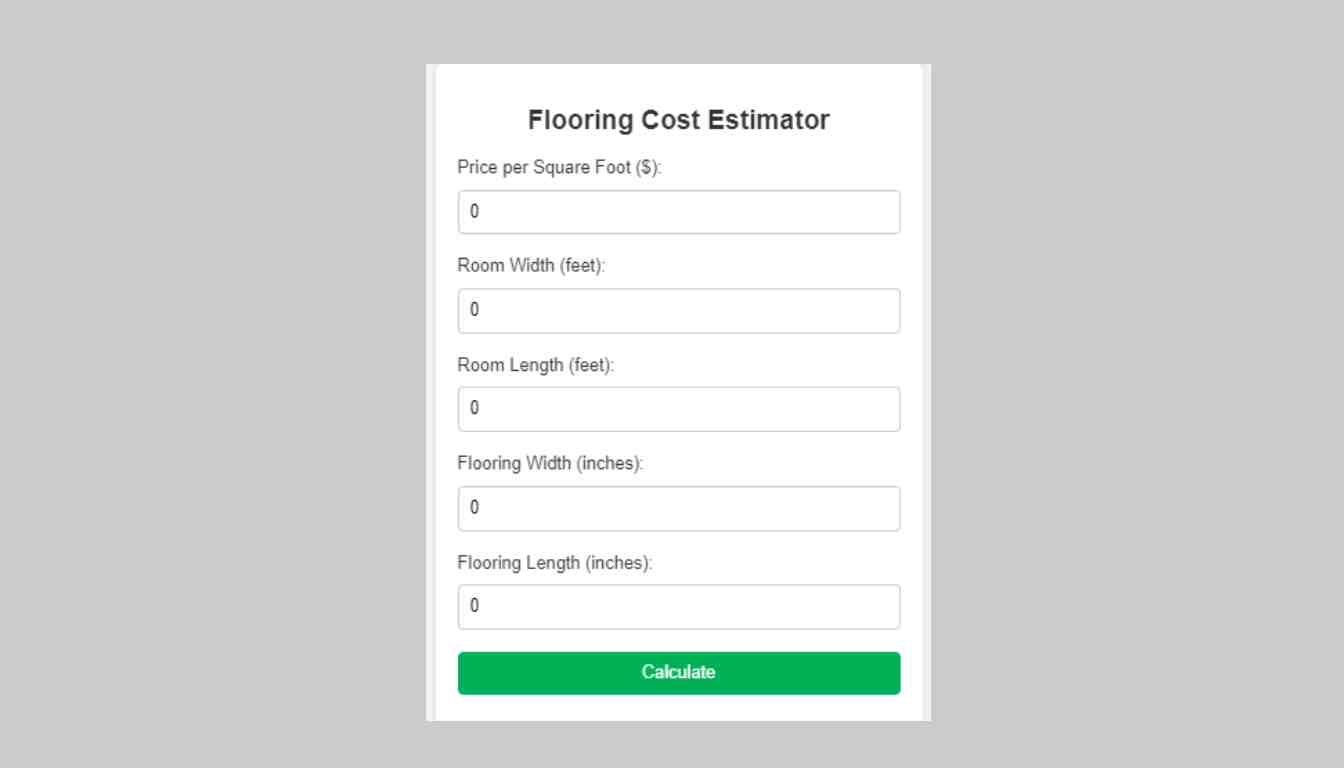A Flooring Cost Estimator provides a personalized quote for new floor installations. It factors in materials, labor, square footage, and other expenses.
Flooring Cost Estimator
Choosing the right flooring for your home or business can dramatically enhance the space’s aesthetics and functionality. With a multitude of options such as hardwood, laminate, tile, or carpet, finding a flooring solution that aligns with your style preferences and budget is essential.
A Flooring Cost Estimator simplifies this process by offering a straightforward way to budget for your project. It considers the type of flooring, the size of the area, and the complexity of the installation to give you a clear financial picture. As you embark on the journey to transform your space, this tool becomes invaluable in planning and executing your flooring project efficiently.

Credit: homeguide.com
Introduction To Flooring Cost Estimation
Welcome to the essential guide on Flooring Cost Estimation. Whether revamping a room or planning a new construction, understanding the financial aspect of flooring is crucial. This guide serves as a starting point to help homeowners and contractors alike navigate the complexities of budgeting for flooring.
Importance Of Accurate Estimates
An accurate flooring cost estimate ensures you set a realistic budget. It helps prevent over-spending and allows for better financial planning. Not only does it streamline the renovation process, but it also avoids unexpected expenses, ensuring a smooth project flow.
Variables In Flooring Costs
Flooring cost estimation is not a one-size-fits-all task. Several key factors impact the overall price:
- Material Types: From luxury hardwood to affordable laminate, prices vary widely.
- Floor Area: Larger spaces require more materials and labor.
- Labor Rates: Installation costs differ based on skill and location.
- Removal of Old Flooring: Do not forget the cost and labor to remove existing flooring.
- Additional Features: Underlays, finishes, and patterns can affect the total cost.

Credit: www.laminate-flooring-installed.com
Types Of Flooring Materials
Choosing the right flooring material is vital. It defines the character of your space and impacts your home’s value. Consider style, durability, and budget before making a decision. Let’s explore the popular options available.
Hardwood Flooring
Hardwood flooring stands out for its elegance. It comes in various species, each with unique grains and colors. Ideal for living rooms and bedrooms, hardwood offers longevity. Maintenance includes refinishing to tackle scratches and wear.
Laminate Flooring
Laminate flooring offers a cost-effective alternative to hardwood. It replicates the look of natural wood while providing higher resistance to scratching and moisture. Laminate works well in busy areas and homes with pets and children.
Tile Flooring
Tile flooring shines in versatility with materials like ceramic, porcelain, and natural stone. Resistant to water and stains, tile is a favorite for bathrooms and kitchens. Its durability makes it suitable for high-traffic zones.
Carpet
Carpet adds warmth and comfort underfoot. Its soft texture makes it a popular choice for bedrooms. Carpets come in numerous colors, patterns, and piles. They excel in sound absorption, providing a quieter home environment.
Vinyl
Vinyl proves excellent for high-moisture areas. It mimics the look of wood or stone at a lower cost. Vinyl’s resilient nature allows easy cleaning and maintenance. Ideal for bathrooms and kitchens, it also feels soft underfoot.
Measuring Your Space
Beginning a flooring project? Accurate measurement is key. Knowing your space’s size ensures you buy the right amount of materials. Cost control starts with precise square footage knowledge. Dive into the steps for measuring your space.
Tools Needed For Measurement
Collect the right tools for an easy measuring process. Here’s what you need:
- Tape measure: A retractable, flexible ruler.
- Notepad and pen: Keep your measurements recorded.
- Calculator: Adds up your totals quickly.
- Graph paper: Sketch your space for reference.
Calculating Square Footage
Calculating your room’s area is simple. Follow these concise steps:
- Measure the length and width of the room in feet.
- Write the numbers down to avoid forgetting.
- Multiply length by width to find square footage.
- Repeat for each room or space being renovated.
- Sum up all the rooms’ area for the total square footage.
For irregular spaces, break them into rectangles and calculate each one. Add those areas together for the entire square footage.

Credit: www.ozburn-hesseycompany.com
Factors Influencing Flooring Prices
Are you preparing to refresh your home with new flooring? Understanding the costs involved is crucial. Various factors influence the price of flooring. These elements ensure every project is unique. Your final bill reflects these diverse components.
Material Quality
The type of flooring material plays a pivotal role in pricing. Options vary from affordable vinyl to premium hardwood. Luxury materials, like high-end tile or exotic woods, command higher prices. Common materials, like laminate, offer savings.
- Hardwood: Durable, but often expensive.
- Laminate: Cost-effective with a wood-like appearance.
- Tile: Offers multiple price points based on quality.
Labor Costs
Installation complexity impacts labor costs. Simple layouts cost less. Intricate patterns or spaces increase labor hours. Professional expertise also affects pricing. Skilled installers ensure quality but might charge more.
| Layout Type | Expected Labor Cost |
|---|---|
| Basic | Lower Cost |
| Complex | Higher Cost |
Geographical Location
Where you live affects flooring prices. High cost-of-living areas often see elevated flooring costs. Material availability in your region can influence price. Transport fees for materials contribute to the overall cost.
Removal Of Old Flooring
Don’t overlook old flooring removal. The process can be labor-intensive. Materials like tile or glued-down carpet increase removal efforts. This additional work extends hours and raises overall costs.
- Determine flooring type to remove.
- Assess removal complexity.
- Factor in disposal fees.
Costs By Flooring Type
Understanding flooring costs by type is crucial for homeowners and renovators. Each flooring option carries a distinct cost structure influenced by material, durability, and style. Breaking down these expenses helps with budget planning and selecting the right flooring for any space.
Price Ranges For Common Flooring Materials
Flooring prices vary widely based on the materials chosen. Here’s a quick snapshot of potential expenses:
| Material | Cost per Square Foot |
|---|---|
| Laminate | $1 – $5 |
| Vinyl | $1 – $7 |
| Carpet | $1 – $4 |
| Ceramic Tile | $1.50 – $5 |
| Hardwood | $4 – $12 |
| Stone | $5 – $10 |
Pros And Cons Affecting Price
Selecting flooring involves weighing multiple factors. Below, we consider the advantages and disadvantages that impact pricing:
-
Durability: Tough materials like stone last longer but cost more upfront.
-
Maintenance: Options like vinyl are low-cost and easy to maintain.
-
Installation: Some floors, such as hardwood, require professional installation, which adds to their cost.
-
Comfort: Carpet offers a soft step but may require more frequent replacement.
-
Style: Trendy materials can command higher prices due to their popularity.
-
Eco-Friendliness: Green options like bamboo may have premium pricing but offer long-term savings and reduce environmental impact.
Additional Costs To Consider
Stepping into a flooring project can be exciting. Yet, the true cost isn’t just in the materials. Be sure to account for hidden expenses. These extra costs help ensure your flooring looks and performs its best.
Underlayment And Subfloor Preparation
Floors crave a solid start. Proper underlayment and subfloor prep are key. They give your flooring the base it needs. Don’t skip!
- Underlayment: This layer sits between your flooring and the subfloor. It can help with noise, moisture, and comfort.
- Subfloor Repairs: Squeaky or uneven? It could need fixing. Check before you lay new flooring. Repairs might add to the cost.
Delivery And Taxes
Materials need to reach your home. Delivery fees can add up. Remember, heavier products like tile often cost more to ship. Taxes are part of every purchase. They vary by location. Include these in your budget.
Thresholds And Baseboards
The details make the difference. Thresholds transition between rooms smoothly. They protect the edges where floors meet. Baseboards add a finished look and cover gaps. Choosing new ones? That’s an added expense.
| Item | Average Cost |
|---|---|
| Thresholds | $5-$10 per foot |
| Baseboards | $1-$5 per foot |
Diy Vs Professional Installation
Choosing between DIY and professional flooring installation is a big decision. Your choice affects your time, budget, and the final look of your project. Do you take on the challenge yourself, or hire experts? A detailed cost estimator helps you decide.
Cost-benefit Analysis
Understanding the costs of DIY versus professional flooring is crucial. You may save on labor costs with DIY. But consider tool rentals and materials. Professionals might get discounts on materials and offer warranties.
| Aspect | DIY | Professional |
|---|---|---|
| Material Costs | Full Price | Discounted |
| Labor Costs | $0 (Your Time) | By Quote |
| Tool Rental | Required | Not Needed |
| Time Investment | High | Minimal |
| Warranty/Guarantee | None | Usually Offered |
Potential Pitfalls Of Diy
- Time Management: DIY projects can take longer than expected. Are you ready to commit?
- Skill Level: Do you have the skills? Mistakes can be costly.
- Tools: Proper tools are essential. Renting or buying them adds to your budget.
- Final Quality: Professional finishes can be hard to achieve. Can you match that level?
- Hidden Costs: Unexpected issues can arise, leading to more expenses.
Estimating The Longevity And Roi Of Flooring Choices
Estimating the Longevity and ROI of Flooring Choices is crucial. It shapes the future value and appeal of your property. Different floors last for varying periods. Some need more upkeep. It’s key to consider these factors before choosing a flooring type.
Projected Lifespan
Every flooring type has a unique lifespan. Hardwood can last for decades with proper care. Tile is known for its long-lasting qualities. Laminates and vinyl offer a shorter lifespan but still provide years of service. The table below outlines typical lifespans for common flooring types:
| Flooring Type | Average Lifespan |
|---|---|
| Hardwood | 75-100 years |
| Tile | 20-50 years |
| Laminate | 15-25 years |
| Vinyl | 10-20 years |
Maintenance Costs Over Time
Maintenance can affect overall flooring costs. Hardwood floors need refinishing. Carpets require professional cleaning. Tile might need grout care. Consider these maintenance tasks to keep floors looking great. Below, find typical maintenance needs and associated costs.
- Hardwood Refinishing: Every 7-10 years, may cost $3-8 per square foot
- Carpet Cleaning: Annually, around $0.20 per square foot
- Tile Grout Maintenance: Occasional resealing, about $2 per square foot
Tips For Budgeting Your Flooring Project
Embarking on a flooring project brings many decisions, but none as foundational as the budget. It sets the groundwork for what’s possible. Effective budgeting allows for a smooth project flow. Here are expert tips to help you plan financially.
Setting Realistic Budgets
Start with research. Gather costs from various sources. Include materials and labor.
Remember to factor in extra costs. Underlayment, delivery, and tools might add up. An accurate budget prevents unexpected surprises.
- Estimate the total area to cover
- Consider different flooring types and their costs per square foot
- Add 10% to your calculation for waste and mishaps
Use a flooring cost estimator. Many are available online. They give a close estimate to work with.
Where To Splurge And Save
Decide where quality matters most.
| Area to Spend | Area to Save |
|---|---|
| High-traffic areas | Less visible spots |
| Long-lasting materials | Temporary solutions |
The living room floor might need more investment than a closet. Look for durability in family spaces. Opt for budget-friendly options in low-impact areas.
Consider the long-term benefit. A higher initial cost can mean lower maintenance expenses.
Discounts can cut costs. Check for sales or bulk buy offers. Prioritize value over the lowest price tag.
Using Online Cost Estimators
Tackling a home renovation project starts with a realistic budget. One handy tool is an online cost estimator for flooring. It helps to answer the big question – how much will my new floors cost?
Reliability Of Online Tools
Online calculators offer a quick glance at potential costs. But remember, these tools provide estimates. Actual expenses may vary. Factors such as material choice, labor costs, and additional fees play a role in the final tally.
- Always cross-check: Don’t rely on a single tool. Compare different estimators.
- Update regularly: Costs change. Ensure you’re using current pricing data.
How To Use Digital Estimators Effectively
Maximize digital tools by being prepared. Gather accurate measurements of your space. Choose your flooring material. Consider the patterns and layouts. Factor in the underlayment and any additional materials needed for installation. Below is a step-by-step guide:
- Measure your room: Record the length and width in feet or meters.
- Select flooring: Click on your chosen material for a rough price.
- Add details: Include underlayment, trims, and removal of old flooring.
Negotiating With Contractors
Negotiating with contractors is a crucial step in managing flooring costs. It’s where savvy homeowners can make significant savings. With the right approach, you can ensure you’re getting the best deal without sacrificing quality. Let’s delve into understanding quotes and finding strategies for cost savings.
Understanding Quotes
Becoming familiar with the details in contractor quotes is the starting point for negotiating. Quotes often include:
- Material costs
- Labor charges
- Project timelines
- Additional fees
Review each item to see what’s necessary. Ask questions if anything seems unclear. Experts recommend getting at least three quotes for comparison.
Strategies For Cost Saving
After reviewing quotes, it’s time to talk cost savings. Effective strategies include:
| Strategy | How It Saves Money |
|---|---|
| Material Choice | Opting for less expensive materials that still meet your needs |
| Bulk Purchase | Buying materials in bulk often leads to discounts |
| Timing Flexibility | Contractors may offer lower rates during their off-peak seasons |
Discuss these strategies with contractors. Agree on a fair price that suits both parties. Remember to get everything in writing to avoid future disputes.
Final Thoughts: Maximizing Your Investment
Exploring the final phase of your flooring project means considering how to truly maximize your financial investment. The choices made now can affect both the immediate costs and long-term value of your flooring.
Long-term Value Considerations
When investing in flooring, think beyond the price tag. Floors endure daily traffic and impact the look and feel of your space. Quality materials may come with a higher upfront cost, but their durability often means fewer replacements and repairs. Selecting the right type of flooring can also add to your property’s resale value. Consider hardwood or high-quality laminate for areas with heavy use. Both are known for their longevity and appeal.
Creating A Contingency Budget
Unexpected costs can arise during home improvement projects. It’s smart to prepare for surprises. An effective flooring cost estimator should include a contingency budget. This is extra money set aside to cover unforeseen expenses. Aim for 10-20% of your project’s total cost to be safe. This added buffer ensures you can handle any additional work without stretching your finances too thin. It helps finish your project smoothly, keeping stress and overruns in check.
- Assess the entire scope of your project carefully.
- Plan for both labor and materials.
- Research potential extra costs, like subfloor repairs.
- Include these assessments in your total estimate.
With these final thoughts on maximizing your flooring investment, ensuring every dollar works its hardest for you is critical. Not only does your choice echo through the years in terms of quality and aesthetics, but a well-crafted budget safeguards against the unpredictable, preserving your peace of mind and wallet.
Frequently Asked Questions For Flooring Cost Estimator
How Much Does Hardwood Flooring Cost?
Hardwood flooring typically ranges from $6 to $12 per square foot for materials alone. Installation can add an additional $3 to $5 per square foot. The total cost depends on the wood type, plank size, and finish.
Is Laminate Flooring More Affordable?
Yes, laminate flooring is more affordable, with an average price between $1 to $5 per square foot for materials. Installation costs usually range from $2 to $4 per square foot. Laminate offers a cost-effective alternative with a wide range of designs.
Can Tile Floors Increase Home Value?
Tile floors can increase home value due to their durability and timeless appeal. They are particularly beneficial in bathrooms and kitchens. High-quality tile flooring is often seen as a valuable upgrade by potential homebuyers.
What’s The Cost Of Carpet Installation Per Room?
Carpet installation typically costs between $3. 50 and $11 per square foot including materials. For a standard-sized room, this translates to approximately $400 to $1,100. Prices will vary based on carpet type and room dimensions.
Conclusion
Estimating the cost of new flooring can be complex. Our guide simplifies this task, offering clarity and precision. Remember, the final price hinges on factors like material, labor, and room size. Ready to revamp your space? Use our Flooring Cost Estimator to budget wisely and bring your vision to life.


